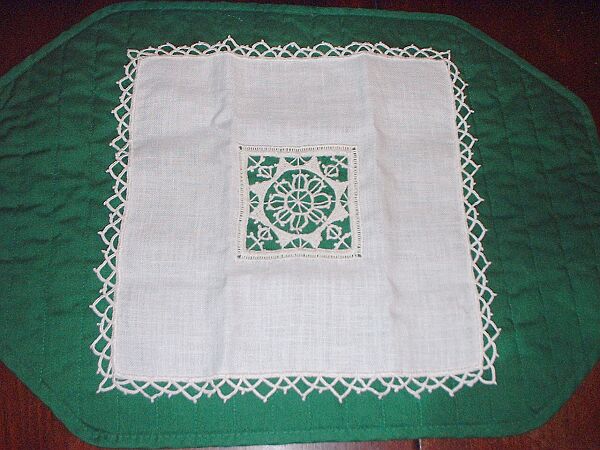|
|
|
|
|
|
|

|
Materials: 32-ct. white linen white silk twist (Rainbow Gallery "Elegance")
Stitches: The edging is an attached punto-in-aria (pattern in Vecellio) in buttonhole stitch with Venetian buttonhole picots. To create the needlelace, I used two separate pattern cards (one for the center motif and one for the edging border) sketched on manila file folder material in permanent ink. The pattern cards were pricked with two holes at each intersection and holding bars were stitched in black silk thread on the card stock to hold the needlelace as it was being made. The center was first outlined in running stitch and buttonhole, then the linen was cut leaving four threads each of warp and weft crossing in the middle. This opening was stitched down to the card pattern for the center and the needlelace built on the pattern. After the needlelace was finished, the holding threads were cut and the linen removed from the card stock. The edges were made similarly. The edge of the handkerchief was folded over once and held with a simple running stitch. The first edge was then attached to the card stock edging pattern which had been prepared with holding stitches. When the needlelace and buttonholing for the side was finished, the holding threads were cut and the handkerchief removed, then new holding threads were stitched onto the pattern and the next edge of the handkerchief attached. To make the drawn thread border around the center, threads were removed parallel to the original buttonholing. The new border was buttonholed on the sides and the perpendicular threads overcast in groups of three.
Pattern Sources:
Vinciolo, Federic. Renaissance Patterns for Lace and Embroidery; An Unabridged Facsimile of the 'Singuliers et Nouveaux Pourtraicts' of 1587. New York: Dover, 2000.
Similar Pieces: At www.kipar.org/costumes_survive_accessories.html is another 17th c. handkerchief from the Victoria & Albert with four corner areas and edging in drawn-thread, whitework, reticella, and punto-in-aria.
Background: The techniques used for both are (1) laying and couching of foundation threads, (2) buttonhole stitch over edges, foundations, and major pattern lines, (3) overcast stitch over "brides" (thin linking and strengthening threads), (4) various detached and open buttonhole stitches as fillings, (5) sometimes needleweaving (Genoa, basket-stitch, darning-stitch), and (6) often picots.
Sources:
Cave, Oenone. Cut-Work Embroidery and How to Do It. New York: Dover, 1982. Rev. ed. of Linen Cut-Work, London: Vista Books, 1963.
Clements, Diane. "Lessons in Reticello" in The Needleworker magazine:
De Dillmont, Therese. The Complete Encyclopedia of Needlework. Running Press, 1996. 3rd ed. Orig. pub. by Dollfus-Mieg Company (France), 1884. Also called DMC Encyclopedia.
Henney, Charla (Mistress Meadhbh ni Dhubhthaigh): Needlelace. Online at www.geocities.com/monstonitrus/ a_and_s/needlelace/needlelace.html, originally in Tournaments Illuminated #138, April 2001.
Kliot, Jules and Kaethe. The Needle-Made Lace of Reticella. Berkeley, CA: Lacis Publications, 1994. Reprinted selections from various sources, orig. 1881-1926, including a large section from Therese De Dillmont's Needle-Made Laces, c. 1910.
The Lace Fairy: lace.lacefairy.com/ID/Identify.html. Several useful articles, most of which are accessible from the given overview of lace types.
Montclare, Kay. Needlearts website:
Vecellio, Cesare. Pattern Book of Renaissance Lace: A Reprint of the 1617 Edition of the 'Corona delli Nobili e Virtuose Dame'. New York: Dover, 1988. Also published as Pizzi Antichi nei disegni di Cesare Vecellio by SugarCo (Milan), 1980.
Vinciolo, Federic. Renaissance Patterns for Lace and Embroidery; An Unabridged Facsimile of the 'Singuliers Et Nouveaux Pourtraicts' of 1587. New York: Dover, 2000. Also at www.pbm.com/~lindahl/vinciolo, the 1606 edition (3rd printing). |
|
|
|
To contact Carol Hanson by e-mail click here. |
Home |
Usage |
Forums |
Articles |
Patterns |
Graphics |
Extras |
Contact Us